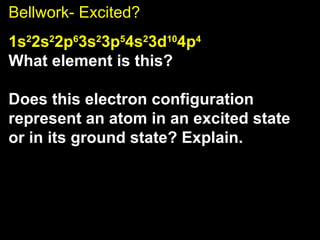Lecture 6.3- Periodic Trends (Honors)
•Télécharger en tant que PPT, PDF•
1 j'aime•752 vues
Section 6.3 lecture for Honors Chem
Signaler
Partager
Signaler
Partager

Recommandé
Recommandé
Contenu connexe
Tendances
Tendances (20)
B.sc(microbiology and biotechnology and biochemistry) ii inorganic chemistry ...

B.sc(microbiology and biotechnology and biochemistry) ii inorganic chemistry ...
En vedette
En vedette (7)
Similaire à Lecture 6.3- Periodic Trends (Honors)
Similaire à Lecture 6.3- Periodic Trends (Honors) (20)
CHEMISTRY-TOPIC-3-Trends.docx trends in the periodic table

CHEMISTRY-TOPIC-3-Trends.docx trends in the periodic table
Classification of elements and periodicity in properties class 11th chapter 3...

Classification of elements and periodicity in properties class 11th chapter 3...
Plus de Mary Beth Smith
Plus de Mary Beth Smith (20)
Chapter 3 and 5 lecture- Ecology & Population Growth

Chapter 3 and 5 lecture- Ecology & Population Growth
Biotechnology Chapter Five Lecture- Proteins (part b)

Biotechnology Chapter Five Lecture- Proteins (part b)
Biotechnology Chapter Five Lecture- Proteins (part a)

Biotechnology Chapter Five Lecture- Proteins (part a)
Dernier
APM Welcome
Tuesday 30 April 2024
APM North West Network Conference, Synergies Across Sectors
Presented by:
Professor Adam Boddison OBE, Chief Executive Officer, APM
Conference overview:
https://www.apm.org.uk/community/apm-north-west-branch-conference/
Content description:
APM welcome from CEO
The main conference objective was to promote the Project Management profession with interaction between project practitioners, APM Corporate members, current project management students, academia and all who have an interest in projects.APM Welcome, APM North West Network Conference, Synergies Across Sectors

APM Welcome, APM North West Network Conference, Synergies Across SectorsAssociation for Project Management
Dernier (20)
Call Girls in Dwarka Mor Delhi Contact Us 9654467111

Call Girls in Dwarka Mor Delhi Contact Us 9654467111
Kisan Call Centre - To harness potential of ICT in Agriculture by answer farm...

Kisan Call Centre - To harness potential of ICT in Agriculture by answer farm...
Measures of Central Tendency: Mean, Median and Mode

Measures of Central Tendency: Mean, Median and Mode
APM Welcome, APM North West Network Conference, Synergies Across Sectors

APM Welcome, APM North West Network Conference, Synergies Across Sectors
Beyond the EU: DORA and NIS 2 Directive's Global Impact

Beyond the EU: DORA and NIS 2 Directive's Global Impact
Web & Social Media Analytics Previous Year Question Paper.pdf

Web & Social Media Analytics Previous Year Question Paper.pdf
IGNOU MSCCFT and PGDCFT Exam Question Pattern: MCFT003 Counselling and Family...

IGNOU MSCCFT and PGDCFT Exam Question Pattern: MCFT003 Counselling and Family...
Z Score,T Score, Percential Rank and Box Plot Graph

Z Score,T Score, Percential Rank and Box Plot Graph
Lecture 6.3- Periodic Trends (Honors)
- 1. Bellwork- Excited? 1s 2 2s 2 2p 6 3s 2 3p 5 4s 2 3d 10 4p 4 What element is this? Does this electron configuration represent an atom in an excited state or in its ground state? Explain.
- 2. Bellwork- Excited? 1s 2 2s 2 2p 6 3s 2 3p 5 4s 2 3d 10 4p 4 What element is this? As Does this electron configuration represent an atom in an excited state or in its ground state? Explain.
- 3. Bellwork- Excited? 1s 2 2s 2 2p 6 3s 2 3p 5 4s 2 3d 10 4p 4 What element is this? As Does this electron configuration represent an atom in an excited state or in its ground state? Explain. This As atom is in an excited state; One of the four electrons in the 4p sublevel could relax because a lower energy 3p orbital is unfilled.
- 4. Lecture 6.3- Periodic Trends
- 10. A neutral atom contains an equal number of protons and electrons. When an atom gains or loses electrons it is no longer neutral. It becomes a charged ion. An ion has a charge.
- 11. If an atom or a compound becomes charged it is called an ion
- 12. A positive ion is called a cation A negative ion is called an anion Positive + Positive + Positive +
- 13. Anakin NEGATIVE
- 14. When an atom gains an electron it gains an additional negative charge. A Chlorine atom will gain one electron to become a Chlorine anion. Cl e - _
- 15. An Oxygen atom will gain two electrons making an Oxygen ion with a charge of negative two. O e - e - _ 2-
- 16. Atoms of elements from the left side of the periodic table will lose electrons. When an atom loses an electron it has more protons than electrons, so it is a positively charged ion.
- 17. Sodium will lose one electron to create a sodium ion with a “plus one” charge Na e - +
- 18. A Magnesium atom will lose two electrons to form an ion with a charge of positive two. Mg e - + e - 2+
Notes de l'éditeur
- This diagram lists the atomic radii of seven nonmetals. An atomic radius is half the distance between the nuclei of two atoms of the same element when the atoms are joined.
- The size of atoms tends to decrease from left to right across a period and increase from top to bottom within a group. Predicting If a halogen and an alkali metal are in the same period, which one will have the larger radius?
- This graph plots atomic radius versus atomic number for 55 elements. INTERPRETING GRAPHS a. Analyzing Data Which alkali metal has an atomic radius of 238 pm? b. Drawing Conclusions Based on the data for alkali metals and noble gases, how does atomic size change within a group? c. Predicting Is an atom of barium, atomic number 56, smaller or larger than an atom of cesium (Cs)?
- First ionization energy tends to increase from left to right across a period and decrease from top to bottom within a group. Predicting Which element would have the larger first ionization energy—an alkali metal in period 2 or an alkali metal in period 4?